Relationship Between Antisocial Behavior and Crime: A Review
VerifiedAdded on 2023/06/13
|7
|1498
|270
Literature Review
AI Summary
This literature review examines the relationship between antisocial behaviors and the commission of criminal offenses, highlighting the impact of antisocial traits on communities and individual well-being. It explores how factors such as genetics, substance abuse, and poor parenting contribute to antisocial behaviors, which can manifest as traits like sadism and psychopathy, potentially leading to criminal activities. The review synthesizes various sources to understand the underlying causes and patterns of crime related to antisocial behavior, noting that early intervention and addressing family issues are crucial for prevention. The review concludes by advocating for further research into the genetic components of antisocial behaviors and emphasizes the importance of legal and social measures to manage and mitigate these behaviors, suggesting that addressing these issues early in life can significantly reduce the likelihood of future criminal activity. Desklib offers more resources like this for students.
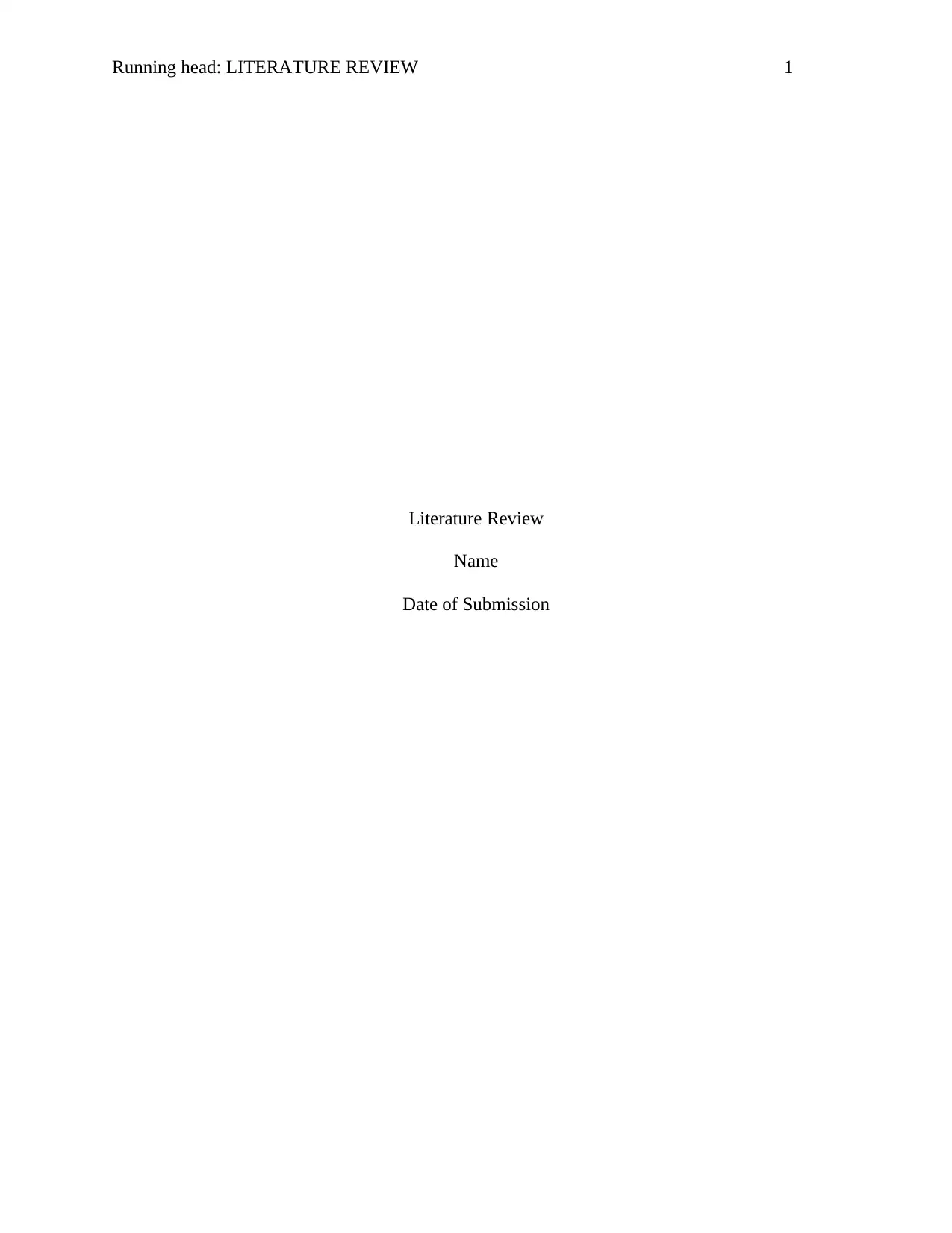
Running head: LITERATURE REVIEW 1
Literature Review
Name
Date of Submission
Literature Review
Name
Date of Submission
Paraphrase This Document
Need a fresh take? Get an instant paraphrase of this document with our AI Paraphraser
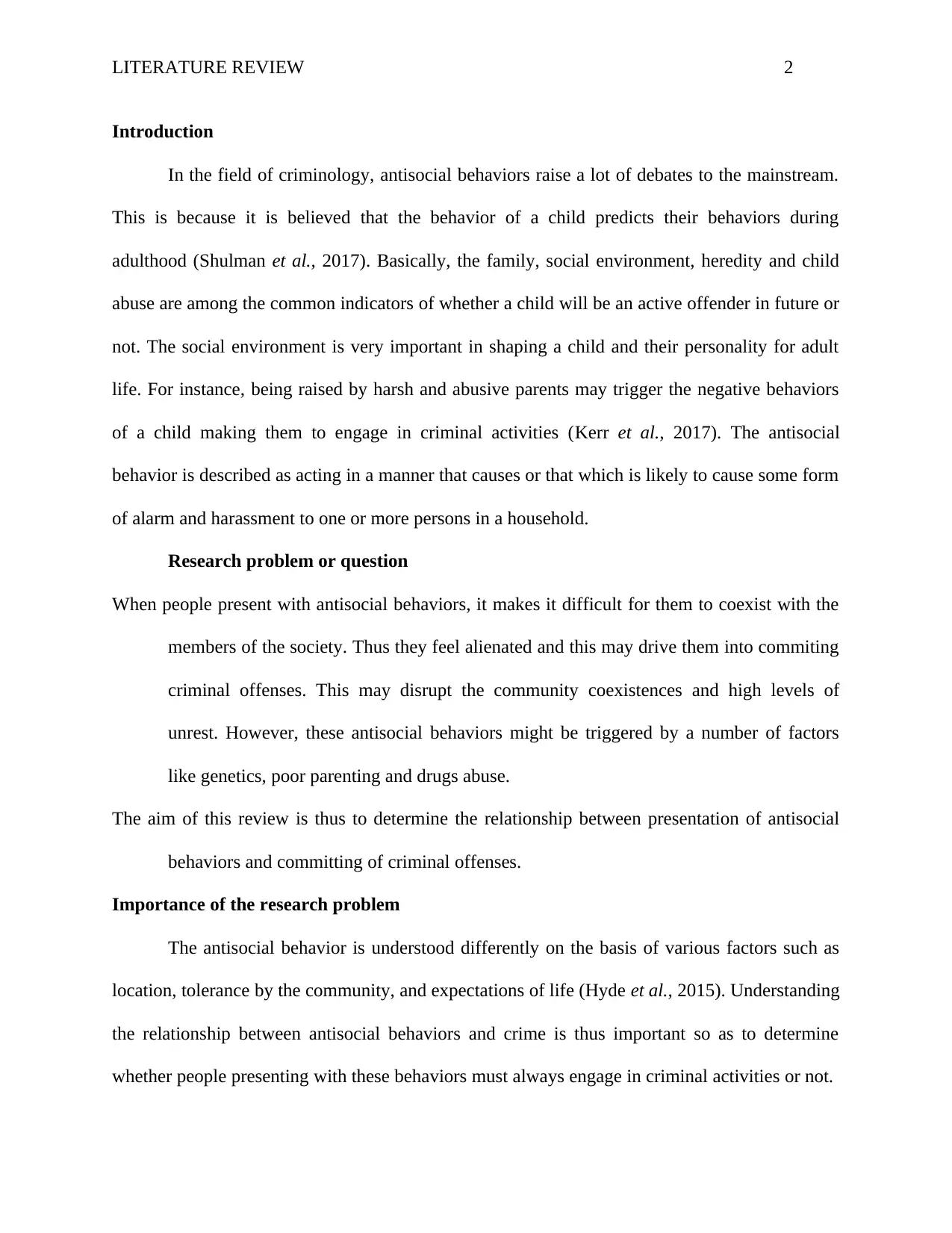
LITERATURE REVIEW 2
Introduction
In the field of criminology, antisocial behaviors raise a lot of debates to the mainstream.
This is because it is believed that the behavior of a child predicts their behaviors during
adulthood (Shulman et al., 2017). Basically, the family, social environment, heredity and child
abuse are among the common indicators of whether a child will be an active offender in future or
not. The social environment is very important in shaping a child and their personality for adult
life. For instance, being raised by harsh and abusive parents may trigger the negative behaviors
of a child making them to engage in criminal activities (Kerr et al., 2017). The antisocial
behavior is described as acting in a manner that causes or that which is likely to cause some form
of alarm and harassment to one or more persons in a household.
Research problem or question
When people present with antisocial behaviors, it makes it difficult for them to coexist with the
members of the society. Thus they feel alienated and this may drive them into commiting
criminal offenses. This may disrupt the community coexistences and high levels of
unrest. However, these antisocial behaviors might be triggered by a number of factors
like genetics, poor parenting and drugs abuse.
The aim of this review is thus to determine the relationship between presentation of antisocial
behaviors and committing of criminal offenses.
Importance of the research problem
The antisocial behavior is understood differently on the basis of various factors such as
location, tolerance by the community, and expectations of life (Hyde et al., 2015). Understanding
the relationship between antisocial behaviors and crime is thus important so as to determine
whether people presenting with these behaviors must always engage in criminal activities or not.
Introduction
In the field of criminology, antisocial behaviors raise a lot of debates to the mainstream.
This is because it is believed that the behavior of a child predicts their behaviors during
adulthood (Shulman et al., 2017). Basically, the family, social environment, heredity and child
abuse are among the common indicators of whether a child will be an active offender in future or
not. The social environment is very important in shaping a child and their personality for adult
life. For instance, being raised by harsh and abusive parents may trigger the negative behaviors
of a child making them to engage in criminal activities (Kerr et al., 2017). The antisocial
behavior is described as acting in a manner that causes or that which is likely to cause some form
of alarm and harassment to one or more persons in a household.
Research problem or question
When people present with antisocial behaviors, it makes it difficult for them to coexist with the
members of the society. Thus they feel alienated and this may drive them into commiting
criminal offenses. This may disrupt the community coexistences and high levels of
unrest. However, these antisocial behaviors might be triggered by a number of factors
like genetics, poor parenting and drugs abuse.
The aim of this review is thus to determine the relationship between presentation of antisocial
behaviors and committing of criminal offenses.
Importance of the research problem
The antisocial behavior is understood differently on the basis of various factors such as
location, tolerance by the community, and expectations of life (Hyde et al., 2015). Understanding
the relationship between antisocial behaviors and crime is thus important so as to determine
whether people presenting with these behaviors must always engage in criminal activities or not.
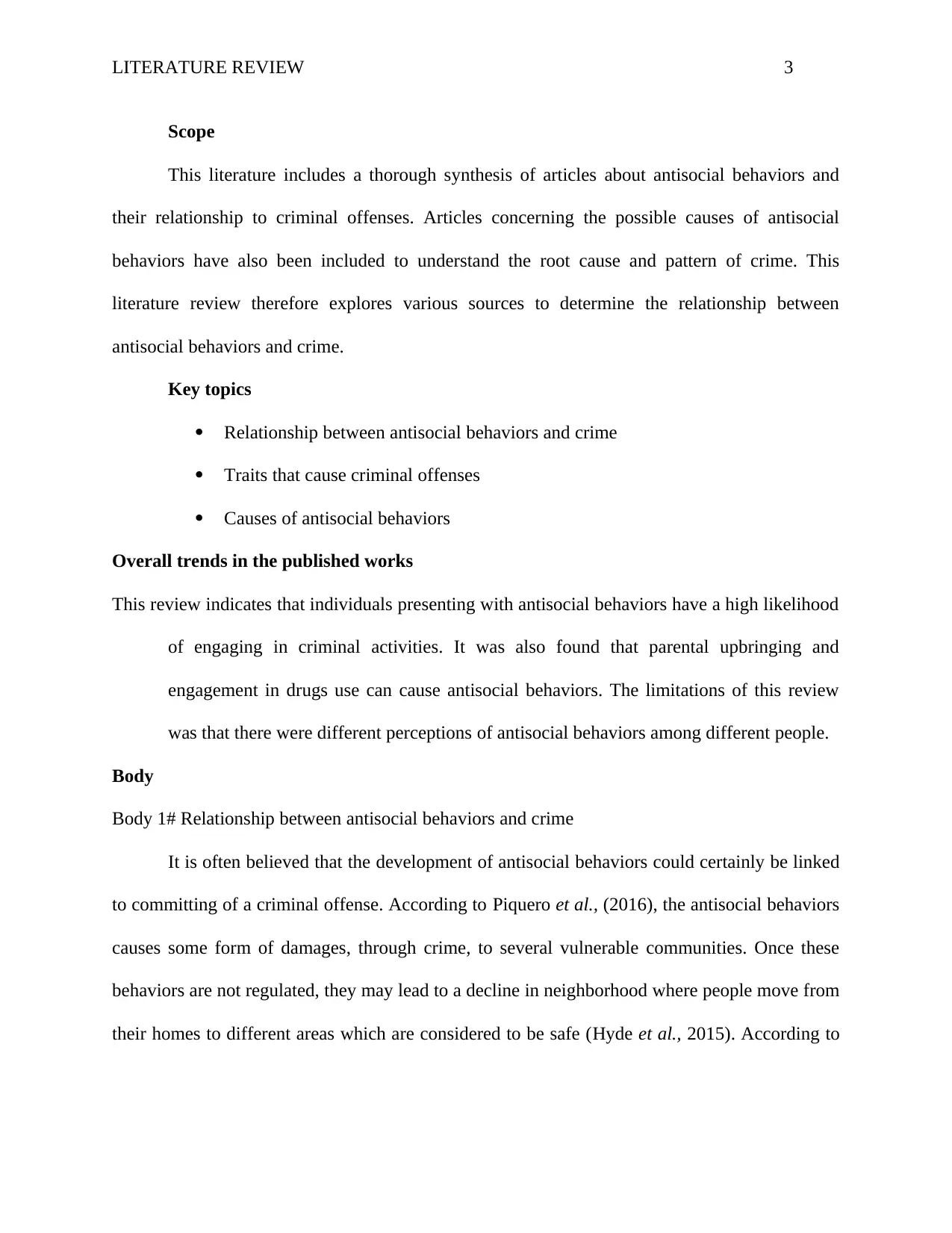
LITERATURE REVIEW 3
Scope
This literature includes a thorough synthesis of articles about antisocial behaviors and
their relationship to criminal offenses. Articles concerning the possible causes of antisocial
behaviors have also been included to understand the root cause and pattern of crime. This
literature review therefore explores various sources to determine the relationship between
antisocial behaviors and crime.
Key topics
Relationship between antisocial behaviors and crime
Traits that cause criminal offenses
Causes of antisocial behaviors
Overall trends in the published works
This review indicates that individuals presenting with antisocial behaviors have a high likelihood
of engaging in criminal activities. It was also found that parental upbringing and
engagement in drugs use can cause antisocial behaviors. The limitations of this review
was that there were different perceptions of antisocial behaviors among different people.
Body
Body 1# Relationship between antisocial behaviors and crime
It is often believed that the development of antisocial behaviors could certainly be linked
to committing of a criminal offense. According to Piquero et al., (2016), the antisocial behaviors
causes some form of damages, through crime, to several vulnerable communities. Once these
behaviors are not regulated, they may lead to a decline in neighborhood where people move from
their homes to different areas which are considered to be safe (Hyde et al., 2015). According to
Scope
This literature includes a thorough synthesis of articles about antisocial behaviors and
their relationship to criminal offenses. Articles concerning the possible causes of antisocial
behaviors have also been included to understand the root cause and pattern of crime. This
literature review therefore explores various sources to determine the relationship between
antisocial behaviors and crime.
Key topics
Relationship between antisocial behaviors and crime
Traits that cause criminal offenses
Causes of antisocial behaviors
Overall trends in the published works
This review indicates that individuals presenting with antisocial behaviors have a high likelihood
of engaging in criminal activities. It was also found that parental upbringing and
engagement in drugs use can cause antisocial behaviors. The limitations of this review
was that there were different perceptions of antisocial behaviors among different people.
Body
Body 1# Relationship between antisocial behaviors and crime
It is often believed that the development of antisocial behaviors could certainly be linked
to committing of a criminal offense. According to Piquero et al., (2016), the antisocial behaviors
causes some form of damages, through crime, to several vulnerable communities. Once these
behaviors are not regulated, they may lead to a decline in neighborhood where people move from
their homes to different areas which are considered to be safe (Hyde et al., 2015). According to
⊘ This is a preview!⊘
Do you want full access?
Subscribe today to unlock all pages.

Trusted by 1+ million students worldwide
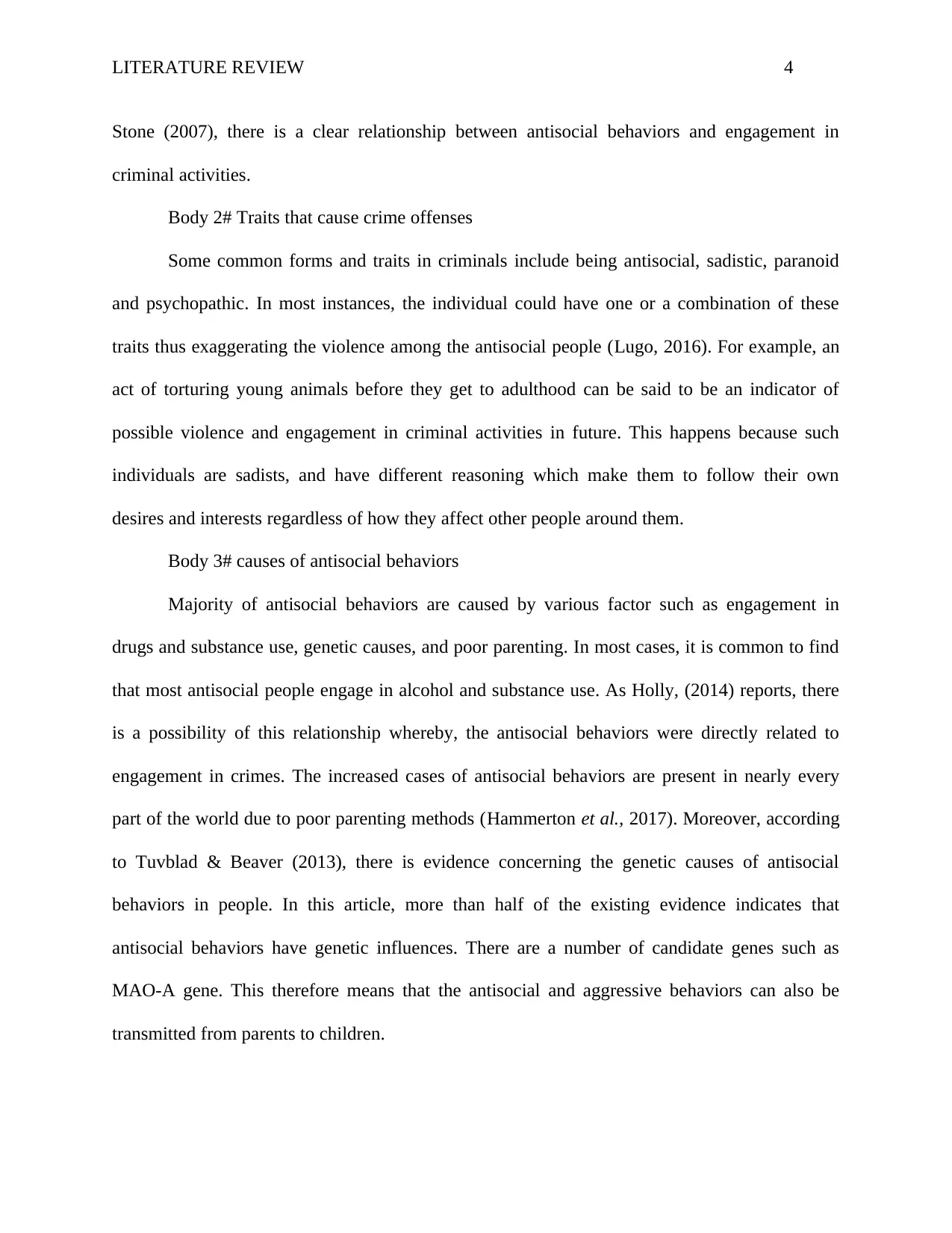
LITERATURE REVIEW 4
Stone (2007), there is a clear relationship between antisocial behaviors and engagement in
criminal activities.
Body 2# Traits that cause crime offenses
Some common forms and traits in criminals include being antisocial, sadistic, paranoid
and psychopathic. In most instances, the individual could have one or a combination of these
traits thus exaggerating the violence among the antisocial people (Lugo, 2016). For example, an
act of torturing young animals before they get to adulthood can be said to be an indicator of
possible violence and engagement in criminal activities in future. This happens because such
individuals are sadists, and have different reasoning which make them to follow their own
desires and interests regardless of how they affect other people around them.
Body 3# causes of antisocial behaviors
Majority of antisocial behaviors are caused by various factor such as engagement in
drugs and substance use, genetic causes, and poor parenting. In most cases, it is common to find
that most antisocial people engage in alcohol and substance use. As Holly, (2014) reports, there
is a possibility of this relationship whereby, the antisocial behaviors were directly related to
engagement in crimes. The increased cases of antisocial behaviors are present in nearly every
part of the world due to poor parenting methods (Hammerton et al., 2017). Moreover, according
to Tuvblad & Beaver (2013), there is evidence concerning the genetic causes of antisocial
behaviors in people. In this article, more than half of the existing evidence indicates that
antisocial behaviors have genetic influences. There are a number of candidate genes such as
MAO-A gene. This therefore means that the antisocial and aggressive behaviors can also be
transmitted from parents to children.
Stone (2007), there is a clear relationship between antisocial behaviors and engagement in
criminal activities.
Body 2# Traits that cause crime offenses
Some common forms and traits in criminals include being antisocial, sadistic, paranoid
and psychopathic. In most instances, the individual could have one or a combination of these
traits thus exaggerating the violence among the antisocial people (Lugo, 2016). For example, an
act of torturing young animals before they get to adulthood can be said to be an indicator of
possible violence and engagement in criminal activities in future. This happens because such
individuals are sadists, and have different reasoning which make them to follow their own
desires and interests regardless of how they affect other people around them.
Body 3# causes of antisocial behaviors
Majority of antisocial behaviors are caused by various factor such as engagement in
drugs and substance use, genetic causes, and poor parenting. In most cases, it is common to find
that most antisocial people engage in alcohol and substance use. As Holly, (2014) reports, there
is a possibility of this relationship whereby, the antisocial behaviors were directly related to
engagement in crimes. The increased cases of antisocial behaviors are present in nearly every
part of the world due to poor parenting methods (Hammerton et al., 2017). Moreover, according
to Tuvblad & Beaver (2013), there is evidence concerning the genetic causes of antisocial
behaviors in people. In this article, more than half of the existing evidence indicates that
antisocial behaviors have genetic influences. There are a number of candidate genes such as
MAO-A gene. This therefore means that the antisocial and aggressive behaviors can also be
transmitted from parents to children.
Paraphrase This Document
Need a fresh take? Get an instant paraphrase of this document with our AI Paraphraser
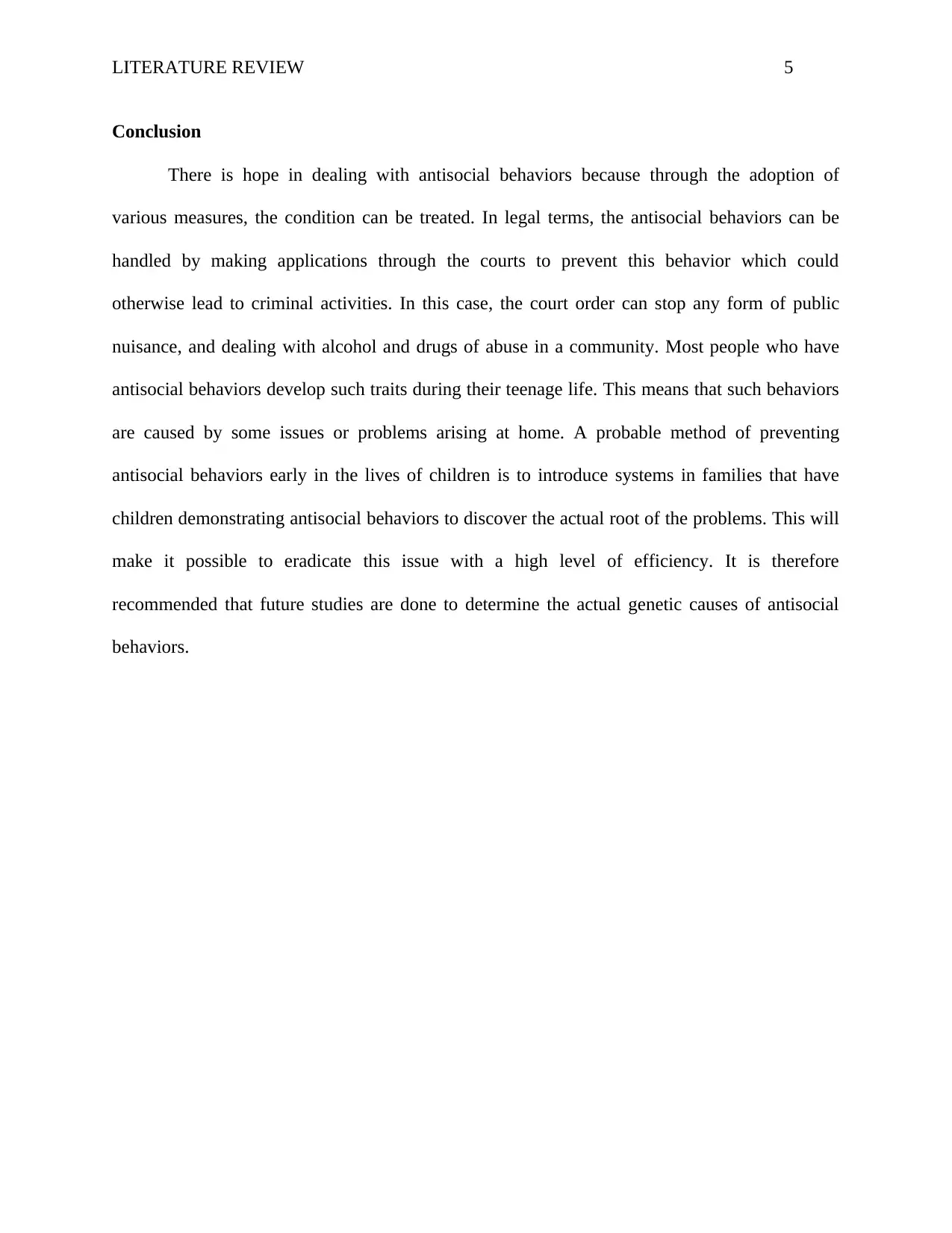
LITERATURE REVIEW 5
Conclusion
There is hope in dealing with antisocial behaviors because through the adoption of
various measures, the condition can be treated. In legal terms, the antisocial behaviors can be
handled by making applications through the courts to prevent this behavior which could
otherwise lead to criminal activities. In this case, the court order can stop any form of public
nuisance, and dealing with alcohol and drugs of abuse in a community. Most people who have
antisocial behaviors develop such traits during their teenage life. This means that such behaviors
are caused by some issues or problems arising at home. A probable method of preventing
antisocial behaviors early in the lives of children is to introduce systems in families that have
children demonstrating antisocial behaviors to discover the actual root of the problems. This will
make it possible to eradicate this issue with a high level of efficiency. It is therefore
recommended that future studies are done to determine the actual genetic causes of antisocial
behaviors.
Conclusion
There is hope in dealing with antisocial behaviors because through the adoption of
various measures, the condition can be treated. In legal terms, the antisocial behaviors can be
handled by making applications through the courts to prevent this behavior which could
otherwise lead to criminal activities. In this case, the court order can stop any form of public
nuisance, and dealing with alcohol and drugs of abuse in a community. Most people who have
antisocial behaviors develop such traits during their teenage life. This means that such behaviors
are caused by some issues or problems arising at home. A probable method of preventing
antisocial behaviors early in the lives of children is to introduce systems in families that have
children demonstrating antisocial behaviors to discover the actual root of the problems. This will
make it possible to eradicate this issue with a high level of efficiency. It is therefore
recommended that future studies are done to determine the actual genetic causes of antisocial
behaviors.
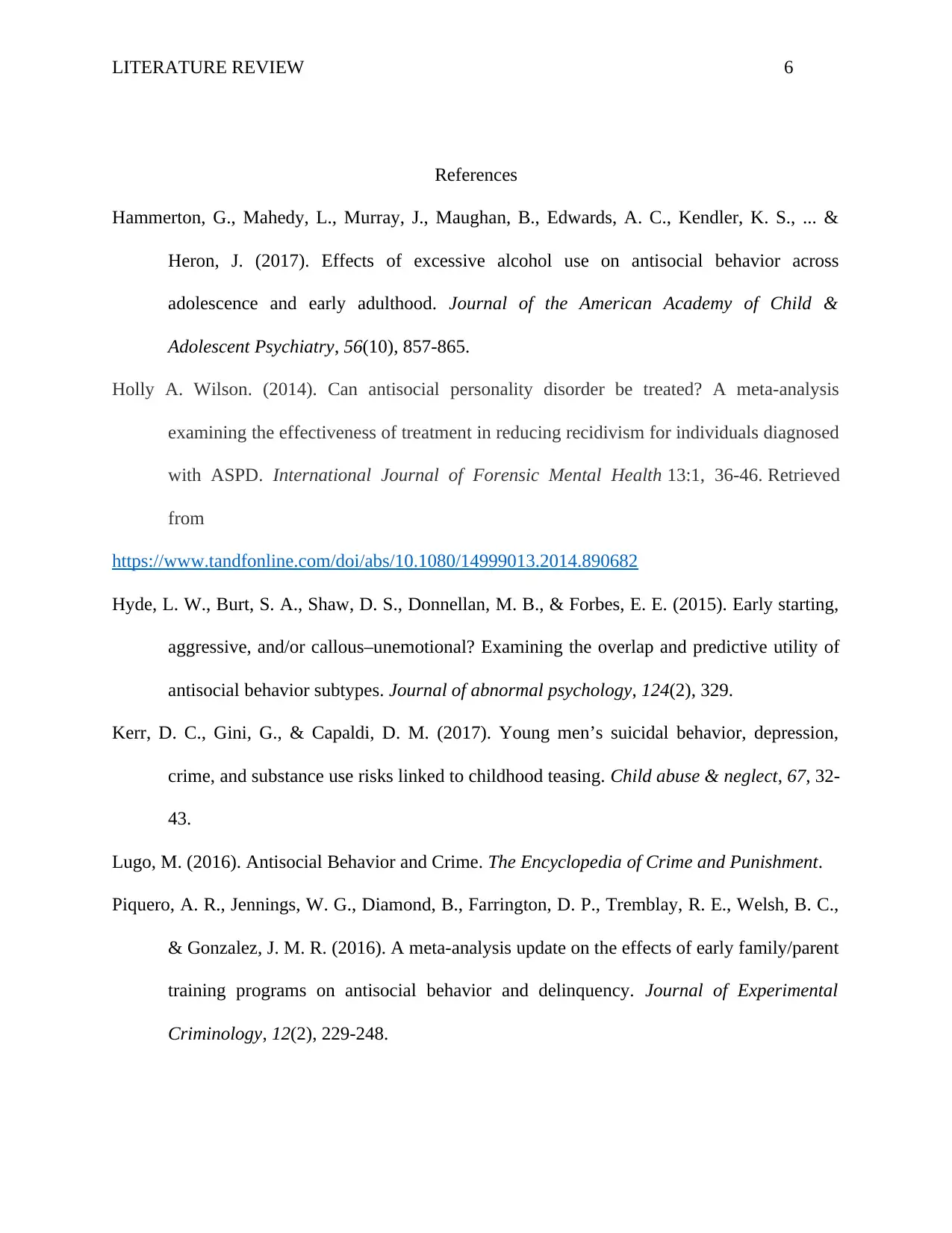
LITERATURE REVIEW 6
References
Hammerton, G., Mahedy, L., Murray, J., Maughan, B., Edwards, A. C., Kendler, K. S., ... &
Heron, J. (2017). Effects of excessive alcohol use on antisocial behavior across
adolescence and early adulthood. Journal of the American Academy of Child &
Adolescent Psychiatry, 56(10), 857-865.
Holly A. Wilson. (2014). Can antisocial personality disorder be treated? A meta-analysis
examining the effectiveness of treatment in reducing recidivism for individuals diagnosed
with ASPD. International Journal of Forensic Mental Health 13:1, 36-46. Retrieved
from
https://www.tandfonline.com/doi/abs/10.1080/14999013.2014.890682
Hyde, L. W., Burt, S. A., Shaw, D. S., Donnellan, M. B., & Forbes, E. E. (2015). Early starting,
aggressive, and/or callous–unemotional? Examining the overlap and predictive utility of
antisocial behavior subtypes. Journal of abnormal psychology, 124(2), 329.
Kerr, D. C., Gini, G., & Capaldi, D. M. (2017). Young men’s suicidal behavior, depression,
crime, and substance use risks linked to childhood teasing. Child abuse & neglect, 67, 32-
43.
Lugo, M. (2016). Antisocial Behavior and Crime. The Encyclopedia of Crime and Punishment.
Piquero, A. R., Jennings, W. G., Diamond, B., Farrington, D. P., Tremblay, R. E., Welsh, B. C.,
& Gonzalez, J. M. R. (2016). A meta-analysis update on the effects of early family/parent
training programs on antisocial behavior and delinquency. Journal of Experimental
Criminology, 12(2), 229-248.
References
Hammerton, G., Mahedy, L., Murray, J., Maughan, B., Edwards, A. C., Kendler, K. S., ... &
Heron, J. (2017). Effects of excessive alcohol use on antisocial behavior across
adolescence and early adulthood. Journal of the American Academy of Child &
Adolescent Psychiatry, 56(10), 857-865.
Holly A. Wilson. (2014). Can antisocial personality disorder be treated? A meta-analysis
examining the effectiveness of treatment in reducing recidivism for individuals diagnosed
with ASPD. International Journal of Forensic Mental Health 13:1, 36-46. Retrieved
from
https://www.tandfonline.com/doi/abs/10.1080/14999013.2014.890682
Hyde, L. W., Burt, S. A., Shaw, D. S., Donnellan, M. B., & Forbes, E. E. (2015). Early starting,
aggressive, and/or callous–unemotional? Examining the overlap and predictive utility of
antisocial behavior subtypes. Journal of abnormal psychology, 124(2), 329.
Kerr, D. C., Gini, G., & Capaldi, D. M. (2017). Young men’s suicidal behavior, depression,
crime, and substance use risks linked to childhood teasing. Child abuse & neglect, 67, 32-
43.
Lugo, M. (2016). Antisocial Behavior and Crime. The Encyclopedia of Crime and Punishment.
Piquero, A. R., Jennings, W. G., Diamond, B., Farrington, D. P., Tremblay, R. E., Welsh, B. C.,
& Gonzalez, J. M. R. (2016). A meta-analysis update on the effects of early family/parent
training programs on antisocial behavior and delinquency. Journal of Experimental
Criminology, 12(2), 229-248.
⊘ This is a preview!⊘
Do you want full access?
Subscribe today to unlock all pages.

Trusted by 1+ million students worldwide
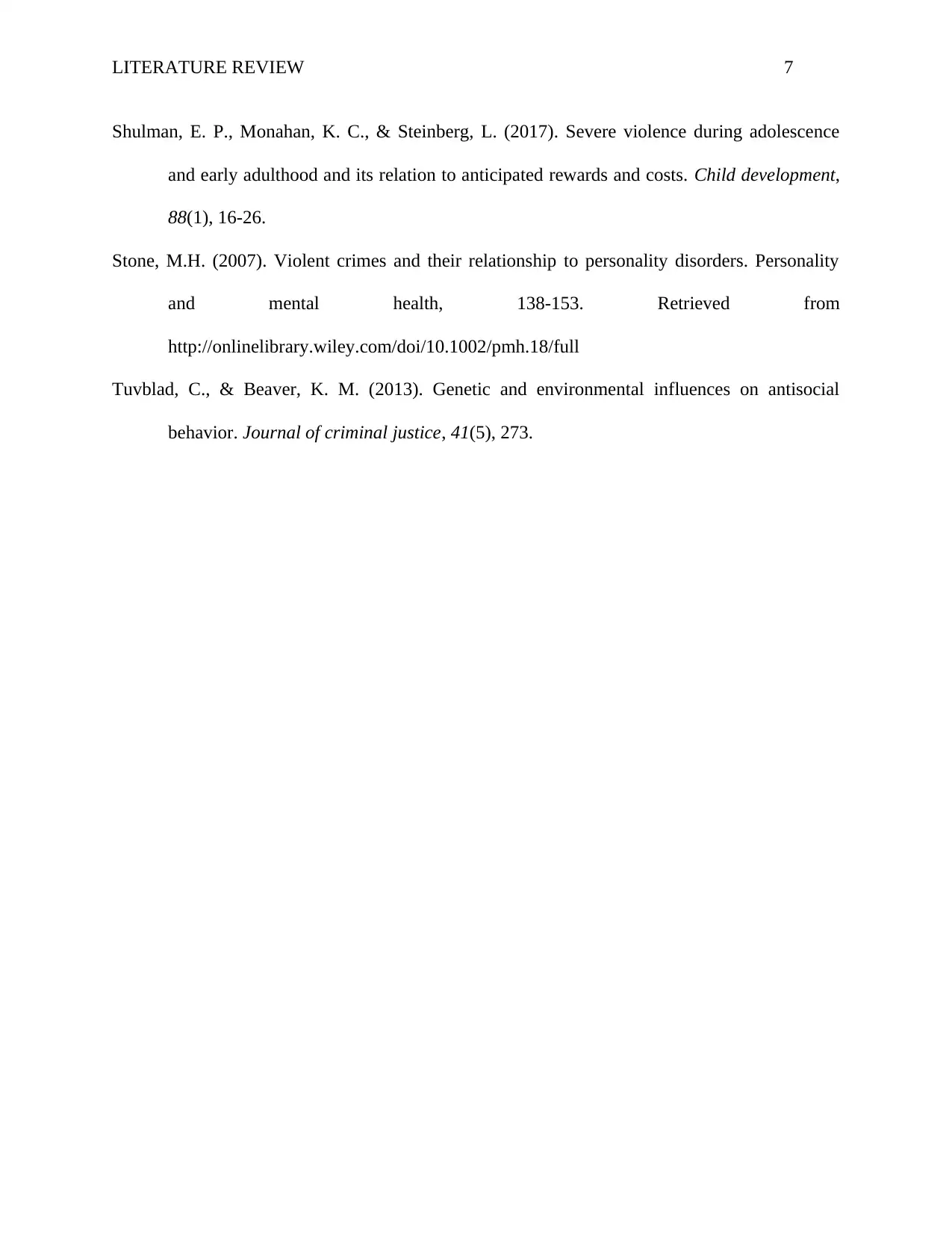
LITERATURE REVIEW 7
Shulman, E. P., Monahan, K. C., & Steinberg, L. (2017). Severe violence during adolescence
and early adulthood and its relation to anticipated rewards and costs. Child development,
88(1), 16-26.
Stone, M.H. (2007). Violent crimes and their relationship to personality disorders. Personality
and mental health, 138-153. Retrieved from
http://onlinelibrary.wiley.com/doi/10.1002/pmh.18/full
Tuvblad, C., & Beaver, K. M. (2013). Genetic and environmental influences on antisocial
behavior. Journal of criminal justice, 41(5), 273.
Shulman, E. P., Monahan, K. C., & Steinberg, L. (2017). Severe violence during adolescence
and early adulthood and its relation to anticipated rewards and costs. Child development,
88(1), 16-26.
Stone, M.H. (2007). Violent crimes and their relationship to personality disorders. Personality
and mental health, 138-153. Retrieved from
http://onlinelibrary.wiley.com/doi/10.1002/pmh.18/full
Tuvblad, C., & Beaver, K. M. (2013). Genetic and environmental influences on antisocial
behavior. Journal of criminal justice, 41(5), 273.
1 out of 7
Related Documents
Your All-in-One AI-Powered Toolkit for Academic Success.
+13062052269
info@desklib.com
Available 24*7 on WhatsApp / Email
![[object Object]](/_next/static/media/star-bottom.7253800d.svg)
Unlock your academic potential
Copyright © 2020–2025 A2Z Services. All Rights Reserved. Developed and managed by ZUCOL.





